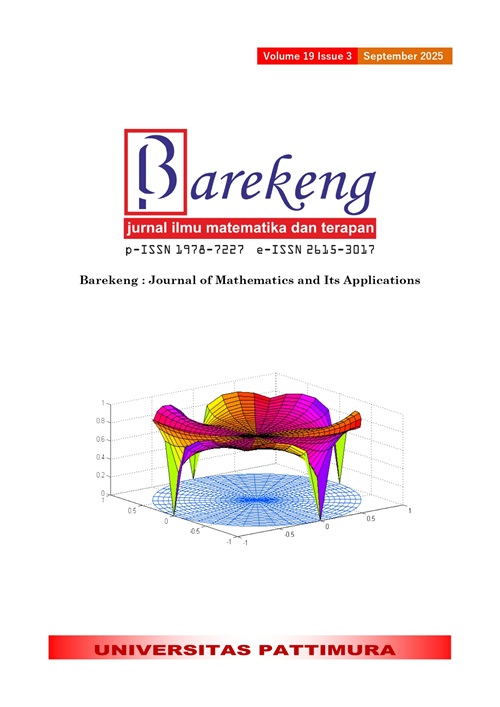SECURING INFORMATION CONFIDENTIALITY: A MATHEMATICAL APPROACH TO DETECTING CHEATING IN ASMUTH-BLOOM SECRET SHARING
Abstract
The Secret Sharing Scheme (SSS) based on the Chinese Remainder Theorem (CRT) is a crucial method for safeguarding confidential information. However, this scheme is vulnerable to collaborative cheating involving multiple participants. This study aims to modify the Asmuth-Bloom scheme by introducing two detection mechanisms: Threshold Range Detection and Detection Parameter Verification, to identify and prevent collaborative fraudulent activities. The research design is based on mathematical algorithms and tests the effectiveness of detection against predetermined cheating scenarios using structured parameters. The results indicate that the proposed modifications can accurately detect the manipulation of secret fragments, even in cases involving participant collusion. This robustness is achieved through the mathematical structure of the CRT, which enables the detection of inconsistencies during the secret reconstruction process. In addition to maintaining the efficiency of the original Asmuth-Bloom scheme, these modifications enhance the reliability of the scheme in protecting sensitive data. The study concludes that the implementation of dual detection mechanisms significantly strengthens the security of the SSS, particularly in applications prone to dishonest participant collaboration. Future research is recommended to explore computational efficiency and the implementation of this scheme in real-world environments, such as financial systems and blockchain technology.
Downloads
References
F. Tita, A. Setiawan, and B. Susanto, “CONSTRUCTION OF SUBSTITUTION BOX (S-BOX) BASED ON IRREDUCIBLE POLYNOMIALS ON GF(2^8),” BAREKENG: Jurnal Ilmu Matematika dan Terapan, vol. 18, no. 1, pp. 0517–0528, 2024, doi: https://doi.org/10.30598/barekengvol18iss1pp0517-0528.
B. P. Tomasouw, G. E. Mado, and E. R. Persulessy, “MATRIKS SCORE DAN APLIKASINYA DALAM PENGAMANAN PESAN RAHASIA,” Barekeng: Jurnal Ilmu Matematika Dan Terapan, vol. 12, no. 2, pp. 107–116, 2018, doi: https://doi.org/10.30598/vol12iss2pp107-116ar623.
L. Harn, Z. Xia, C. Hsu, and Y. Liu, “SECRET SHARING WITH SECURE SECRET RECONSTRUCTION,” Information Sciences, vol. 519, no. 1, pp. 1–8, 2020, doi: https://doi.org/10.1016/j.ins.2020.01.038.
B. Parihar, M. Deshmukh, and A. S. Rawat, “EFFICIENT SINGLE SECRET IMAGE SHARING IN RESOURCE-CONSTRAINED ENVIRONMENT USING COUNTING-BASED SECRET SHARING OVER CLOUD,” Procedia Computer Science, vol. 230, no. 1, pp. 158–167, 2023, doi: https://doi.org/10.1016/j.procs.2023.12.071.
O. Ersoy, T. B. Pedersen, and E. Anarim, “HOMOMORPHIC EXTENSIONS OF CRT-BASED SECRET SHARING,” Discrete Applied Mathematics, vol. 285, no. 1, pp. 317–329, 2020, doi: https://doi.org/10.1016/j.dam.2020.06.006.
A. Alahmadi, A. Altassan, A. K. Al, S. Çalkavur, H. Shoaib, and P. Solé, “A MULTISECRET-SHARING SCHEME BASED ON LCD CODES,” Mathematics, vol. 8, no. 2, pp. 1–10, 2020, doi: https://doi.org/10.3390/math8020272.
Y. Sun, Y. Lu, J. Chen, W. Zhang, and X. Yan, “MEANINGFUL SECRET IMAGE SHARING SCHEME WITH HIGH VISUAL QUALITY BASED ON NATURAL STEGANOGRAPHY,” Mathematics, vol. 8, no. 9, pp. 1–17, 2020, doi: 1 https://doi.org/10.3390/math8091452.
S. Ali, J. Wang, and V. C. Ming Leung, “DEFENSIVE STRATEGIES AGAINST PCC ATTACKS BASED ON IDEAL (T,N)-SECRET SHARING SCHEME,” Journal of King Saud University - Computer and Information Sciences, vol. 35, no. 9, p. 101784, 2023, doi: https://doi.org/10.1016/j.jksuci.2023.101784.
S. Chhabra and A. K. Singh, “SECURITY ENHANCEMENT IN CLOUD ENVIRONMENT USING SECURE SECRET KEY SHARING,” Journal of Communications Software and Systems, vol. 16, no. 3, pp. 296–307, 2020, doi: https://doi.org/10.24138/jcomss.v16i3.964.
K. Shima and H. Doi, “HIERARCHICAL SECRET-SHARING SCHEME BASED ON XOR OPERATIONS,” Journal of Information Processing, vol. 32, no. 1, pp. 719–730, 2024, doi: https://doi.org/10.2197/ipsjjip.32.719.
R. Eriguchi and N. Kunihiro, “STRONG SECURITY OF LINEAR RAMP SECRET SHARING SCHEMES WITH GENERAL ACCESS STRUCTURES,” Information Processing Letters, vol. 164, no. 1, pp. 1–9, 2020, doi: https://doi.org/10.1016/j.ipl.2020.106018.
O. B. Chanu and A. Neelima, “A SURVEY PAPER ON SECRET IMAGE SHARING SCHEMES,” International Journal of Multimedia Information Retrieval, vol. 8, no. 4, pp. 195–215, 2019, doi: https://doi.org/10.1007/s13735-018-0161-3.
A. K. Chattopadhyay, S. Saha, A. Nag, and S. Nandi, “SECRET SHARING: A COMPREHENSIVE SURVEY, TAXONOMY AND APPLICATIONS,” Computer Science Review, vol. 51, no. 1, pp. 1–22, 2024, doi: https://doi.org/10.1016/j.cosrev.2023.100608.
A. Voudouris, A. Tressos, A. Zarras, and C. Xenakis, “GAME ON: A PERFORMANCE COMPARISON OF INTERPOLATION TECHNIQUES APPLIED TO SHAMIR’S SECRET SHARING,” The Computer Journal, vol. 1, no. 1, pp. 1–12, 2024, [Online]. Available: https://watermark.silverchair.com/bxae109.pdf
V. S. Lakshmi, S. Deepthi, and P. P. Deepthi, “COLLUSION RESISTANT SECRET SHARING SCHEME FOR SECURE DATA STORAGE AND PROCESSING OVER CLOUD,” Journal of Information Security and Applications, vol. 60, no. 1, pp. 1–16, 2021, doi: https://doi.org/10.1016/j.jisa.2021.102869.
S. Zhao, Z. Zeng, J. Peng, and F. Yu, “ACHIEVING A SECURE AND TRACEABLE HIGH-DEFINITION MULTIMEDIA DATA TRADING SCHEME BASED ON BLOCKCHAIN,” Mathematics, vol. 11, no. 10, pp. 1–16, 2023, doi: https://doi.org/10.3390/math11102224.
S. A. Bhat, N. F. Huang, I. B. Sofi, and M. Sultan, “AGRICULTURE-FOOD SUPPLY CHAIN MANAGEMENT BASED ON BLOCKCHAIN AND IOT: A NARRATIVE ON ENTERPRISE BLOCKCHAIN INTEROPERABILITY,” Agriculture (Switzerland), vol. 12, no. 1, pp. 1–25, 2022, doi: https://doi.org/10.3390/agriculture12010040.
M. Al Ghamdi, M. Al Ghamdi, and A. Gutub, “SECURITY ENHANCEMENT OF SHARES GENERATION PROCESS FOR MULTIMEDIA COUNTING-BASED SECRET-SHARING TECHNIQUE,” Multimedia Tools and Applications, vol. 78, no. 12, pp. 16283–16310, 2019, doi: https://doi.org/10.1007/s11042-018-6977-2.
S. A. A. Hakeem and H. Kim, “CENTRALIZED THRESHOLD KEY GENERATION PROTOCOL BASED ON SHAMIR SECRET SHARING AND HMAC AUTHENTICATION,” Sensors, vol. 22, no. 1, pp. 1–25, 2022, doi: https://doi.org/10.3390/s22010331.
L. Harn and M. Fuyou, “MULTILEVEL THRESHOLD SECRET SHARING BASED ON THE CHINESE REMAINDER THEOREM,” Information Processing Letters, vol. 114, no. 9, pp. 504–509, 2014, [Online]. Available: https://www.sciencedirect.com/science/article/abs/pii/S0020019014000659
D. Pasailă, V. Alexa, and S. Iftene, “CHEATING DETECTION AND CHEATER IDENTIFICATION IN SECRET SHARING SCHEMES,” International Journal of Computing, vol. 9, no. 2, pp. 107–117, 2010, doi: https://doi.org/10.47839/ijc.9.2.702.
S. Saha, A. K. Chattopadhyay, A. K. Barman, A. Nag, and S. Nandi, “SECRET IMAGE SHARING SCHEMES: A COMPREHENSIVE SURVEY,” IEEE Access, vol. 11, no. 1, pp. 98333–98361, 2023, doi: https://doi.org/10.1109/ACCESS.2023.33040555.
O. S. Althobaiti and M. Dohler, “QUANTUM-RESISTANT CRYPTOGRAPHY FOR THE INTERNET OF THINGS BASED ON LOCATION-BASED LATTICES,” IEEE Access, vol. 9, no. 1, pp. 133185–133203, 2021, doi: https://doi.org/10.1109/ACCESS.2021.3115087.
Copyright (c) 2025 Azhar Janjang Darmawan, Sugi Guritman, Jaharuddin Jaharuddin

This work is licensed under a Creative Commons Attribution-ShareAlike 4.0 International License.
Authors who publish with this Journal agree to the following terms:
- Author retain copyright and grant the journal right of first publication with the work simultaneously licensed under a creative commons attribution license that allow others to share the work within an acknowledgement of the work’s authorship and initial publication of this journal.
- Authors are able to enter into separate, additional contractual arrangement for the non-exclusive distribution of the journal’s published version of the work (e.g. acknowledgement of its initial publication in this journal).
- Authors are permitted and encouraged to post their work online (e.g. in institutional repositories or on their websites) prior to and during the submission process, as it can lead to productive exchanges, as well as earlier and greater citation of published works.






1.gif)



